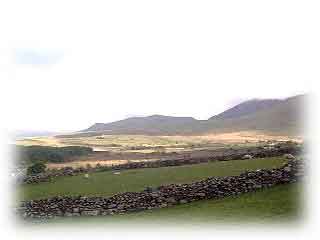Martha
of Mynydd Llanllyfni
The
following account is based on incidents which took
place on Mynydd Llanllyfni in about 1740, only a
few years after the Witchcraft Acts were abolished
in 1736. There had been no convictions under this
act for 24 years as by then no reasoning, right-minded
magistrate would entertain such accusations which
were invariably lacking in hard evidence. However,
the repeal caused uproar in less enlightened circles.
Some Scottish Presbyterians described it as "an
infraction of the Word of God", and John Wesley,
founder of the Methodists, was outraged, as he equated
giving up the recognition of witchcraft with giving
up the Bible. Unlike other parts of Britain, Europe
and North America, we in Wales are fortunate in having
had no witch-hunts or their gruesome consequences.
 The
beliefs described were still widely held by ordinary
folk and have their roots in Celtic antiquity.
By the 18th century they were seen as evidence of the
ignorance of the common people. The
beliefs described were still widely held by ordinary
folk and have their roots in Celtic antiquity.
By the 18th century they were seen as evidence of the
ignorance of the common people.
Image: Mynydd Llanllyfni. The tale
which follows appeared in Drych yr Amseroedd,
(a Methodist history) 1820 by Rev. Robert Jones,
Rhoslan. Another account is to be found in Nant
Nantlle 1871 by Rev. W Ambrose, drawing heavily
and imperfectly on the above mentioned book and incorporating
some elaborations possibly from oral tradition or
of his own invention. These appear below bracketed
and in Italics.
"Scarcely
do I judge it worthy to write or read about the
shameless stupidity exemplified by an eloquent, pseudo-religious
woman and also of her husband in the conspiracy.
"They
lived in a house on Mynydd Llanllyfni. They made
it known to various people that they had gained
knowledge of certain beings called 'The Invisible
Ones'. The
story they told about them was thus: that they
were a numerous nation, great in wealth and mingled
with
us in fairs and markets and no one could perceive
them but those who devote themselves to go to
their fellowship. The fiends had succeeded in causing
some
to believe that they had travelled, with their
horses and carriages, over the snow without anyone
seeing
any traces. The crafty woman who was mentioned
earlier had got a certain number to believe that
a great
nobleman lived with his daughter in a splendid
mansion near to her house on the mountain, and that
their
names were Mr and Miss Ingram.
"She
gathered together quite a few gullible folk, many
of whom had come from afar to hold a kind of night
meeting, without candles or fire or any other light
except that which came from the embers, as the
Invisible Ones could not bear the light. Sometimes
the old
nobleman would come to preach to them himself;
at other times, the daughter would come, dressed
in
white. (One farmer from Anglesey was so captivated
by the new faith and the hope of marrying Miss Ingram
that he brought all that he owned to Mynydd Llanllyfni
to seek intercession.) Some time elapsed before
the deceit was revealed: it befell that a certain
man (Gutto-wir-gast), more wily than others
of that brotherhood listened intently and realised
quite plainly, that it was the mistress of the house
who had come to deceive them; sometimes in man's
clothing, sometimes in woman's clothing. (Gutto
had noticed that she had burnt her foot and kicked
her, causing her to cry out). The man shouted "Listen
people, without a doubt we are being tricked! I myself
swear that this woman is M________ !" (Martha).
With
this, uproar swept through the house and the poor
creature was forced to flee for his life.
This
devilish deception was discredited, those under its
sway were dispersed, and the woman and her husband
proceeded no further as their foolishness was obvious
to all. (She regretted and confessed her errors
and ended her days as a member of the Methodist Church
in Llanllyfni.)"
Although
the old law against witchcraft has been abolished,
it is still possible for those who claim supernatural
powers (for the purposes of fraud) to be prosecuted.
There is no evidence available from this period of
anyone called Martha being prosecuted.
The
Methodist cause began in Llanllyfni in 1766, that
is to say about 25 years later. If Martha had joined
them, Rev. Robert Jones Rhoslan would have delighted
in the fact, but he does not mention it. Perhaps
by mixing this story with that of the activities
of Mary of the White Mantle (Meironnydd) and also
Joanna Southcott (Lancashire) some 40 years later
(which all appear on the same page in Drych yr Amseroedd)
or with Gwen y Canu at Buarthau, Rev. Ambrose (a
Baptist) tried to create an agreeable end to the
story.
The
name Ingram is significant in that it is so rare
in Wales. At this time, the Ingram family, of Romany
stock, were well known throughout the land. (Considering
the prejudice against the Gypsies, it is surprising
that the Rev. Robert Jones, Rhoslan, did not berate
them for encouraging superstition!) The Romanies
maintained their harmonious attitude to the environment
in an age when so many Gajos (those who are not Romanies)
tended to separate the material world from the world
of the spirit, especially in conventional religion.
By the way, the Gypsies preserved much of our musical
inheritance. Secular music and all dancing were works
of the Devil, according to many Nonconformists! Over
the centuries, the gypsies would, by custom, camp
on Cors y Llyn, Lon Las and Cerrig Mawr in the summer. |